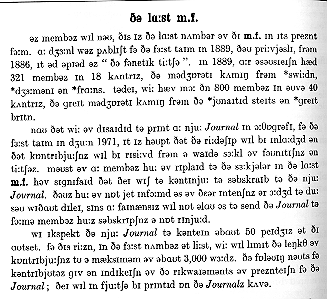
A page from the "Maître phonétique", the journal that the International Phonetic Association used to publish entirely in its phonetic alphabet.
The initials "IPA" are used for both the International Phonetic Alphabet and for the International Phonetic Association which created it. It should usually be clear from context which one is being referred to.
The International Phonetic Association was founded in France in 1886. Most of its original members were language teachers interested in better ways of teaching pronunciation. (In fact, until 1897, its name was the Phonetic Teachers' Assocation.)
The association published the first version of its alphabet in 1888.
The guiding principles for the association as it chose the symbols for its alphabet and decided how they should be used were:
one sound = one symbol
There should be a one-to-one correspondence between a speech sound and the symbol used to represent it. A symbol should always represent the same sound, regardless of the language being transcribed. A sound should always be represented by the same symbol.
A single sound should not be represented by a sequence of symbols, the way that English uses two letters to represent the consonant at the beginning of thin. Nor should a single symbol represent a sequence of sounds, the way the English letter x does in tax.
use letters of the Roman alphabet where possible
The association wanted to avoid making people learn a completely made-up alphabet, such as Bell's Visible Speech, which most found too difficult.
Since there are many more speech sounds than there are letters of the Roman alphabet, many new symbols had to be borrowed or created. Even here, the IPA tried to make the novelty as minimal as possible.
Major sounds are represented by symbols. Minor modifications of sounds are represented by diacritics on symbols.
The number of speech sounds that the human vocal tract can produce is vastly greater than the number of unique symbols that any sane group would want to invent or any person would want to memorize. In order to solve this problem, the IPA includes a number of diacritics, small accent marks that can be placed above, below, or next to a major symbol to indicate that the sound it represents in this case is slightly different from the sound it normally represents. Some examples:
The International Phonetic Alphabet has been revised a number of times since 1888, most recently at the association's 1993 convention in Kiel, with a few minor changes approved in 1996.
The IPA has become widely used: